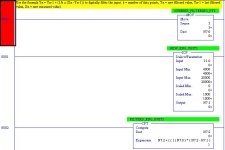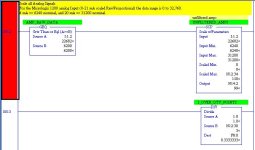Thanks, Guys,
I knew I would get some good ideas. I will try to respond to all your comments. Sliver, I don't actually have it yet, still in design stage, but it will be a Banner Engineering Corp. #SUA923QD, supplied by the conveyor equipment manufacturer, so I cannot change it at this point.
Eric, I like the timer idea. I have put it in the program already. Jesper and Peter, I have decided to go one step farther and try to filter out everything that is not "signal". So I asked, what do I know that would eliminate High and Low values that cannot be the Bin Level Signal? I know the maximum scrap fill rate is 28,000 lb per 8/hour day (conveyor design rate). I know the bin size, and so I can calculate the maximum bin fill rate. Theoretically it will be 0.1 inches/second, so I automatically doubled it to 0.2 to allow for the "real world" unknown factors. I will have to verify this in the field once it is running, and adjust the fill rate factor as necessary.
Now I have a slope of a line, and I will set up PLC calculations as follows: Fill Rate = Absolute Value of [(New Input value - Old Value) / (Time2 - Time1)], where the delta Time will be a constant 1 second, every time the DONE bit goes high. If Fill Rate <= 0.2, then New Filter 1 Value is a Good Signal, otherwise, forget it!
Now if it still doesn't stablilize, then I will take Jesper's idea and say: New Filter 2 Value = [(Old Filter 2 value X "1") + New Filter 1 Value] / 2. Jesper if that doesn't do it, I will change the "1" in the equation to a 2 and change the divisor to a 3, and so on until it looks clean, or until I bump against the 32767 integer number limit. So what do you think? Will this do the job, or am I tilting at windmills?
Has anybody had this type of filtering problem with reading negative pressure in an oven or boiler, where you have to maintain -0.2 inches WG pressure to prevent fumes and smoke from getting into the control room?







